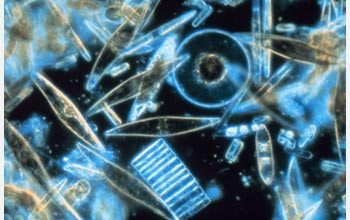
Classification
The way the classification are placed here are as they currently understood and placed into their various phyla, classes, orders, and families.
Diatoms are Eukaryotic and belong to the
Kingdom protista. They further belong to the super group
Chromalveolata and are grouped into the Strameopiles as the lineage
Diatoms. They then form two phyla, Bacillariophyta and
Chrysophyta. They are then divided into 2 orders in each phyla. Then
there are several suborders under each order. Then this is followed
by numerous families and subfamilies.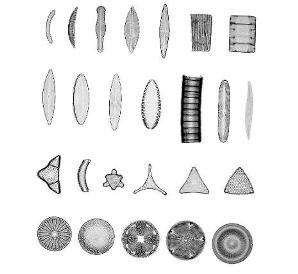
Diatoms are organized into the different orders if they are Pennales (linear symmetry) or Centrales (radial symmetry). They are further divided into their suborders and families by other features of their frustules (pores, spikes, ect.) and by their environment (aquatic, terrestrial, arctic, tropical, ect.). (More on the frustules go to facts)
Domain: Eukarya
Kingdom: Protista
1) Phylum:
Bacillariophyta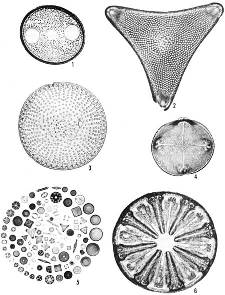
a)
Class: Diatomatae
i) Order: Centrales
(1) Suborder: Discineae
(a) Family: Coscinodiscaceae
(b) Family: Actnodiscaceae
(c) Family: Eupodiscaceae
(2) Suborder: Soleniineae
(a) Family: Soleniaceae
(3) Suborder:Biddulphiineae
(a) Family: Chaetoceraceae
(b) Family: Biddulphiaceae
(c) Family: Anaulaceae
(d) Family: Euodiaceae
ii) Order: Pennales
(1) Suborder: Araphidineae
(a) Family: Fragilariaceae
(2) Suborder: Raphidiodineae
(a) Family: Eunotiaceae
(3) Suborder: Monoraphidineae
(a) Family:Achnanthaceae
(4) Suborder: Biraphidineae
(a) Family: Naviculaceae
(b) Family: Epthemiaceae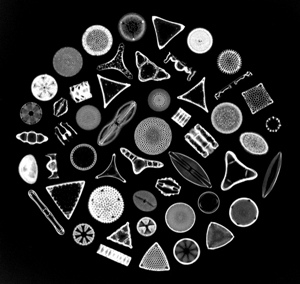
(c) Family: Nitzschiaceae
(d) Family: Surirellaceae
2) Phylum:
Chrysophyta
a)
Class: Bacillariophyceae
i) Order: Bacillariales
(1) Suborder: Coscinodiscineae
(a) Family: Cosinodiscaceae
(b) Family: Hemidiscaceae
(c) Family: Actinodicaceae
(2) Suborder: Aulacodiscineae
(a) Family: Eupodiscaceae
(3) Suborder: Auliscineae
(a) Family: Auliscaceae
(4) Suborder: Biddulphineae
(a) Family: Biddulphiaceae
(b) Family: Anaulaceae
(c) Family: Chaetoceraceae
(5) Suborder: Rhizosoleniineae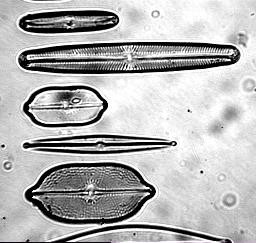
(a) Family: Bacteriastraceae
(b) Family: Leptocylindraceae
(c) Family: Corethranaceae
(d) Family: Rhizosoleniaceae
(6) Suborder: Fragilariineae
(a) Family: Fragilariaceae
(7) Suborder: Eunotiineae
(a) Family: Eunotiaceae
(8) Suborder: Achnanthineae
(a) Family: Achnanthaceae
(9) Suborder: Naviculineae
(a) Family: Naviculaceae
(b) Family: Auriculaceae
(c) Family: Gomphonemaceae
(d) Family: Cymbellaceae
(e) Family: Epithemiaceae
(f) Family: Bacillariaceae
(10) Suborder: Surirellineae
(a) Family: Surirellaceae
ii) Order: Centrales
(1) Suborder: Coscinodiscineae
(a) Family: Melosiraceae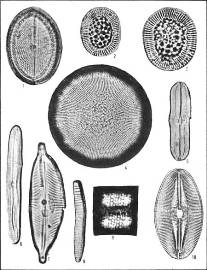
(b) Family: Thalassiosiraceae
(c) Family: Coscinodiscaceae
(d) Family: Asterolampraceae
(e) Family: Heliopeltaceae
(f) Family: Strictodicaceae
(g) Family: Hemidiscaceae
(2) Suborder: Rhizosoleniineae
(a) Family: Pyxillaxeae
(b) Family: Rhizosoleniaceae
(c) Family: Chaetoceraceae
(3) Suborder: Bidulphiineae
(a) Family: Hemiaulaceae
(b) Family: Biddulphiaceae
(c) Family: Eupodiscaceae
(This is an incomplete list of the orders and families.)
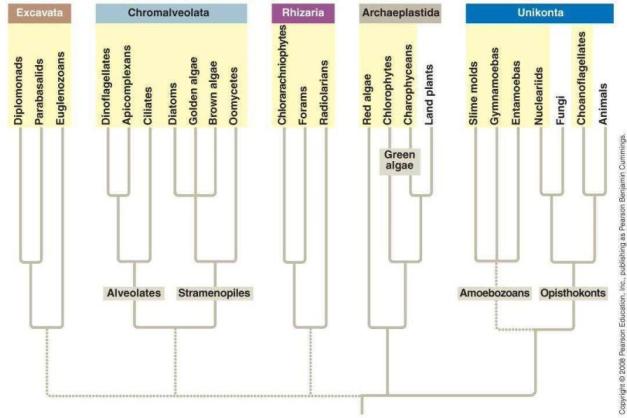
To Habitat